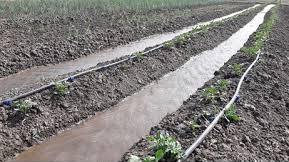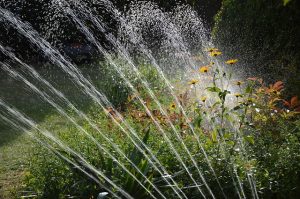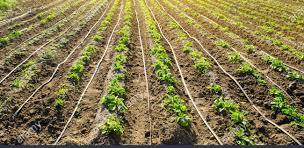WHAT IS IRRIGATION- DIFFERENT METHODS
DEFINITION
Irrigation is the artificial application of water to soil/land for the purpose of supplying essential moisture for crop production.
Since water is essential part of protoplasm and photosynthesis in plants, it becomes very important to plant life.
Soil water is depleted in the form of evaporation from soil surface, transpiration through the plants and deep percolation into the soil and thus moisture content is reduced and plant faces moisture stress. Therefore different methods of irrigation are used for growing plants.
WATER MOVEMENT IN THE SOIL
Water enters into the soil immediately after irrigation and goes through different layers and then withdrawal of water takes place. Water is absorbed mainly through roots either through active absorption or through passive absorption. Water movement in the soil occurs in three different ways-
Saturated flow: when all pores are filled with water, saturated flow occurs. The direction of flow is from higher potential to lower potential.
Unsaturated flow: subsequent water flow in the soil after saturated flow. It means unsaturated movement is in micro pores while macro pores are emptied. The direction of flow is from higher to lower potential.
Vapour Movement: when soil becomes dry, water from micro pores is also emptied and thus water is present in the form of vapour. The movement is from higher to lower vapor pressure area. Under severe drought condition this form of water is very crucial for the survival of plants.
METHODS OF IRRIGATION
Depending on the land slope, amount of water and equipment available, type of crop and method of cultivation; irrigation methods are classified as follows:
- SURFACE IRRIGATION– Most commonly used surface methods are:
- Flooding– water is flown from the channel into the entire field. This method is minimum labour intensive and mainly used for low land rice.
- Check basin method- Most common surface method and suitable for close growing crops like wheat and groundnut. Field is divided into small plots surrounded by bunds on all the four sides. Water from main head is supplied to the field channels one after the other. The size of check basin ranges from 4m*3m to 6m*5m depending upon stream size and texture of soil. In this method water applies uniformly; though wastage of land is more under channels and bunds and inter-cultivation is difficult. This method also requires more labour.
- Ring basin method- This method is suitable for fruit trees and generally these are formed in round shape around the trees.
- Border strip method- In this method field is laid out into long narrow strips bordering with small bunds. Most common size is 30-50m*3-5m in length and width. Suitable for close growing crops and medium to heavy textured soil. Distribution of water is not uniform in this method but inter culture is possible.
- Furrow method- It is usually made by the planned placement of ridges and furrows. A ridge is the part of the layout of the field that is elevated at different angles based on the type of soil. This is actually where the plants are planted. The furrows are the troughs which let the water flow through it. The size and slope of furrow depends on type of crops and spacing used. It provides reduction in cost and higher yield.

Furrow Irrigation - Surge irrigation- It may be defined as intermittent application of water used to improve uniform distribution of water along the furrows. It reduces the percolation losses. Water is switched alternatively from one set of furrows to the other.
- Cablegation- It is an automated method of supplying water for surface irrigation. The pipe is laid on a precise grade, and a plug moves slowly through the pipe, causing water to blow through the outlets in sequence to furrows in the field. This system saves labor and water as compared to other surface methods.
- SUBSURFACE IRRIGATION
Subsurface irrigation requires less maintenance than surface irrigation and there is also less chance of surface saturation and effluent runoff.
By reducing the chance of human contact, it also significantly reduces the public health risks. Water is applied through underground perforated pipes and can be applied through deep trenches too at 15-30 m intervals. Water reaches root zone through capillary movement. Trenches may be used for drainage. Evaporation loss is very low due to dry surface and less weed problem. The demerits are maintenance of pipe lines and deep percolation losses.
- SPRINKLER IRRIGATION
In this method water is applied as spray like rain drops over the crops. The components of this system are pump, main & lateral pipelines, riser pipe and sprinkler. This method offers many advantages as compare to surface irrigation-

Merits:
- Uniform application of water
- No conveyance losses, saves 25-50% of water
- Save 10-15% land, suitable for sandy, shallow soils and saline soil to leach salts
- No risk of runoff, erosion and inundation
- Suitable for areas where water and labour scarcity
- Sprinkling before frost occurrence helps in maintaining higher temperature and minimizing frost damage.
Demerits-
- Difficult to use under high wind velocity and not suitable to hot dry wind areas
- Power requirements are high since it operates at a pressure of 0.5-1.0 kg/cm sq.
- High initial cost and chances of spreading of diseases.
- DRIP/TRICLE IRRIGATION
This is a type of micro-irrigation system that saves water and nutrients by allowing water to drip slowly to the root zone of plants, either from above the soil surface or buried below the surface.
It may be defined as the precise, slow application of water in the form of tiny streams or miniature sprays through emitter devices. The goal is to place water directly into the root zone and minimize evaporation.

Drip irrigation systems distribute water through a network of valves, pipes, tubing, and emitters. Depending on how well designed, installed, maintained, and operated it is, a drip irrigation system can be more efficient than other types of irrigation systems. Components used in drip irrigation are as follows:
- Pump or pressurized water source
- Water filter or filtration systems: sand separator, Fertigation systems (Venturi injector) and chemigation equipment (optional)
- Backwash controller
- Pressure Control Valve
- Distribution lines (main larger diameter pipe, maybe secondary smaller, pipe fittings)
- Hand-operated, electronic, or hydraulic control valves and safety valves
- Smaller diameter polyethylene tube (often called “laterals”)
- Poly fittings and accessories (to make connections)
- Emitting devices at plants (emitter or dripper, micro spray head, inline dripper or inline drip tube)
Merits:
- Best tool for the areas of acute water shortage
- Evaporation, deep percolation and runoff are minimum
- No land leveling and water is maintained at field capacity
- Herbicides and fertilizers can be applied with water through it i.e. Herbigation & fertigation
- Due to high moisture content, soil concentration is less even in salty soils
- Energy requirement is low
- Less disease & weed infestation.
Read more..
WHAT IS SOIL EROSION- TYPES & MECHANISM
WHAT IS DROUGHT- CAUSE & EFFECTS
MULCHING MEANING- TYPES & USAGE
SOIL TYPES IN INDIA: FEATURES
FORMATION OF SOIL-PROCESS & FACTOR OF SOIL FORMATION
TYPES OF FARMING- SYSTEM OF FARMING
CROPPING PATTERN-CROPPING SYSTEM
INTEGRATED FARMING SYSTEM
WHAT IS ORGANIC FARMING